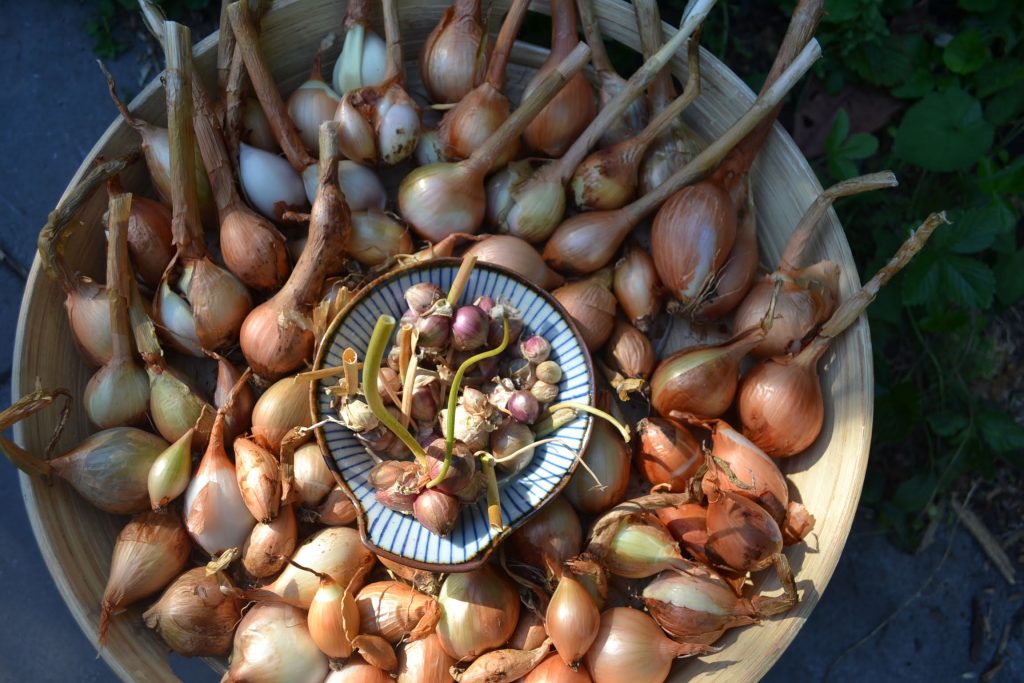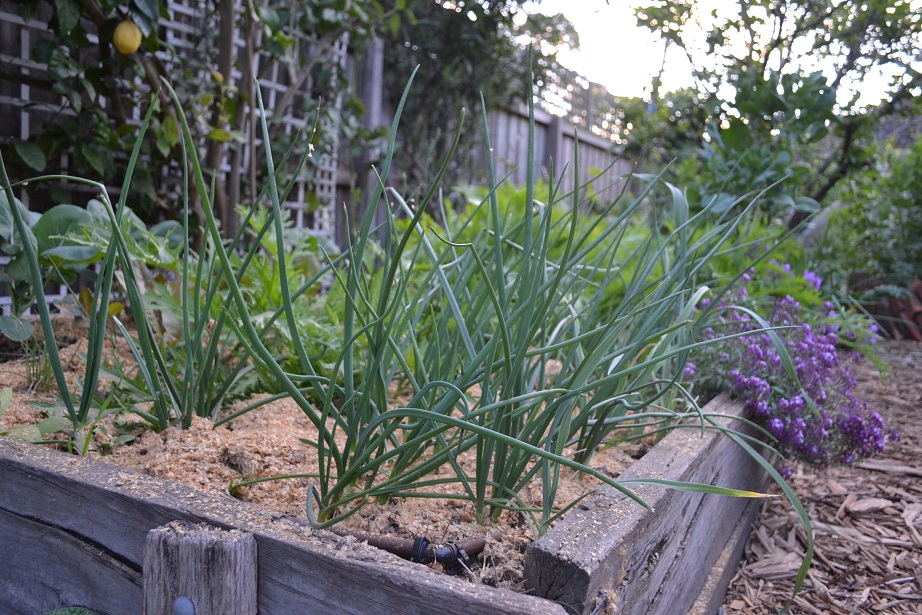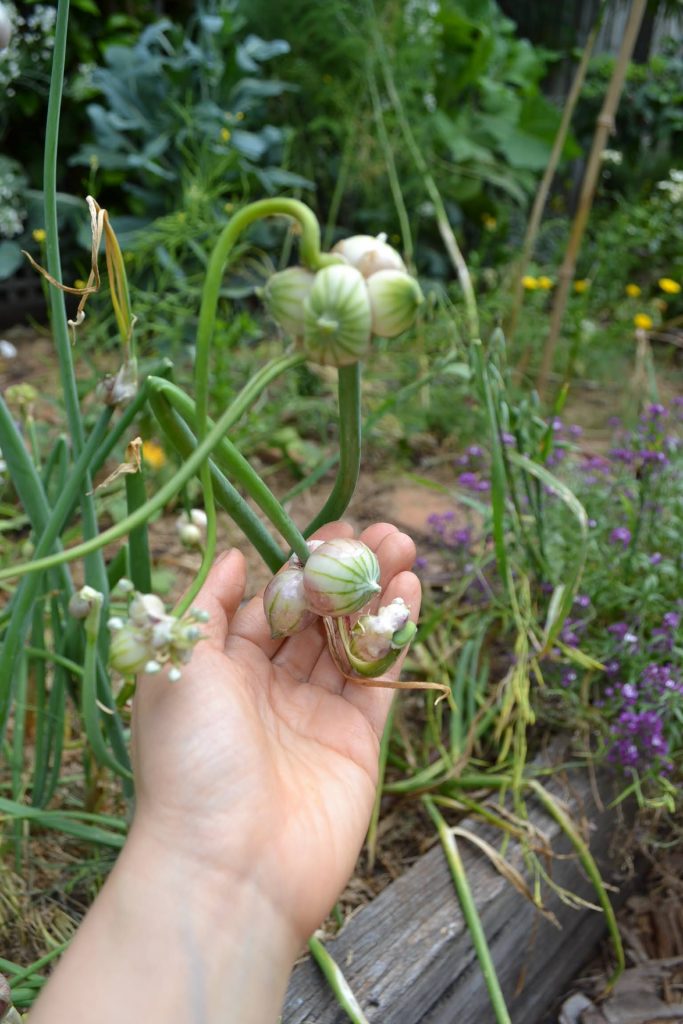Shhh…Here’s our little secret to the easiest onions to grow. Egyptian walking onions! With standard onions, you plant one seed and you get one onion.With Egyptian walking onions, you plant one bulb and get a lifetime supply of onions! Read on to find out more about how to grow these wonderful onions.
Egyptian walking onions (Allium x proliferum) are also known as tree onions or top set onions. They are an heirloom variety of onion and we love everything about them. Check out our video tutorial here or written growing guide below.
Why grow Egyptian walking onions?
1. Firstly, they are perennial – I can’t emphasise this enough, this means they grow back year after year. You don’t need to replant. You don’t need to do anything. Who can bother re-sowing those fiddly tiny onion seeds each year? You’ll never have to again! Egyptian walking onions are an ideal vegetable for your perennial food forest.
2. Secondly, their scientific name is Allium Prolifium – this gives you a clue to how they behave. Believe me they are “prolific”. Egyptian walking onions reward you twice – they are a ‘multiplier onion’ which means they multiply under the ground to produce more onions, while also producing baby bulbs on top in the form of long flower stalks. These baby bulbs eventually get so heavy on their long stalk that they fall over and land on the soil, which is how they literally ‘walk’ across your garden bed over the seasons.
3. Thirdly, they are a wonderful spring onion substitute. Spring onions can be difficult and slow to grow, particularly from seed. Well why bother when you can grow EWOs which double as an onion and spring onion with their lush ever-giving green tops.
Finally, who can resist their name! Onions that can walk? Yes please. We’ve been testing these for years now, and they have the Melbourne Foodforest tick of approval for ease of growing and productiveness. Read on to find out how to grow and harvest them!

Growing Tips – Everything you need to Know!
- Timing: Onions are a cold weather crop, great for filling your veggie beds over winter. So where we are in the Southern hemisphere in Australia, we plant in autumn to winter, between May to July. You’d reverse this in the Northern hemisphere and plant October to December.
- Where to find bulbs: you can get some off our website at select times of the year, or check out other mail order suppliers. Choose between the large bulbs which are ready to go and harvest in one season, or the bulbils, which are smaller and cheaper, but will take a few seasons before they are big enough to harvest.
- How to plant: Plant with the pointy part facing up, and the flat hard base (from which roots will emerge) facing down. Check out our Video tutorial for a visual guide so you can get this right.
- Spacing: Space the large bulbs approximately 20 cm apart, while the small bulbils can be planted much closer about 5 cm apart.
- Soil needs: For the best onions, plant into a soil enriched with generous amounts of compost, worm castings and gentle manure like cow manure. Like with all root vegetables, don’t overfertilise with rich manures like chicken manure or you’ll get all leaves and not many bulbs. You may need to loosen the soil the soil first if your ground is hard as they do like a rich friable, free draining soil. Gently rake the organic matter into the top 2-5cm of the soil. Then gently stick the bulb into the soil, and cover lightly with soil.
- Location: While they can grow in shade, they will grow bigger and faster in a sunny spot. Given they’re growing over winter where the sun is low in the sky and hard to come by, pick your sunniest bed if you want big bulbs.
- Watering: Given they’re a bulb, they are less fussy about watering as they’ve got a good reserve of water in their bulb. We have wet winters where we are, so don’t need to water them all winter. If you have dry winters, give them a good soak once a week, or when dry.
When should I harvest?
Egyptian walking onions give you a dual or should I say triple harvest!
- During the growing season, You can use the blue green leaves as spring onion like greens – they really taste the same as spring onion greens. You can harvest these all winter which is awesome/ I find these much easier to grow than spring onions, which take ages to get established from seed. Just be careful not to harvest too many greens off one plant as they need the leaves for energy to grow the onion bulbs. So just pick a few off each plant at a time and give it time to recover before picking more.

- As we get to summer, you will notice a long green spike coming out from your onion. It will look almost alien like, a white papery sack and unravelling form the inside is a flower spike comprised of baby onions, known as Bulbils! Hence their other name ‘ tree onion’ as they resemble a tree with a ball of onions on the top. Eventually this onion head will get so heavy it’ll topple over onto the soil these mini onions will grow shoots, and this will form a new cluster of onions next season. This cycle repeats your new plants will form bulbils at the top and they will keep walking across your bed. Hence it’s said that these onions can walk across a garden bed. You plant them in one corner and eventually it’ll spread or walk across your bed. Pretty cool!
- The large bulbs under the soil are ready for harvest usually around mid spring to early summer. Dig around the soil a bit and you’ll see the big bulbs poking out. At this time, cut back on any watering and mulch well to prevent excess moisture getting in, as you want the bulbs to harden up and cure, and you don’t want them to rot. If you wait until all the foliage turns yellow before harvesting, this will produce the largest bulbs as all the energy from the leaves have been drawn into the bulbs. If impatient and short on bed space, you can pull out once they’re a good size.

What should you do with the bulbils?
- If you don’t want your onions to walk messily across the beds, harvest the topsets or the bulbils if they’ve tipped over. Just cut them off the stem. It’s also said that cutting off the top sets results in bigger bulbs below so if you want bigger onions, cut off the spike that forms before it has time to fully mature.
- Keep the cute bulbils that form on the flower spikes. You can replant them or eat them. If replanted, each one will eventually become one of these large bulbs but it does take a couple of season to fatten them up as they are a lot smaller than the onion bulbs under the ground.

How do you store Egyptian Walking Onions?
- Like standard onions, leave them somewhere dry to cure e.g. in the shed, your pantry or a cool dry room in your house. Curing means letting the outer skin dry out and become papery. Once cured they can store all summer until winter for you to enjoy.
- If you’re not planning on eating them you can leave them in the soil and they will reshoot in autumn. However in a backyard like ours we are always short on bed space particularly over summer, so I pull them out and store them indoors, and this allows me to plant more capsicum and tomatoes. By pulling them out you’re also thinning them. If you leave them in the soil you’ll eventually get a massive cluster of onions which will become less productive over time.
What do they taste like?
Last but not least, you are no doubt wondering: What do they taste like? Not surprisingly, they taste just like standard onions and shallots. They are quite sweet and not too biting.
Use them in all your dishes where you’d use onions like pasta sauces, salads, soups and stir fries. They are smaller than your short-bought supermarket onions, and we find them easier to prepare and more versatile. They’re also great for roasting or pickling – particularly the little bulbils which you can pickle whole!
As always, thank you for reading and watching! Please remember to subscribe to our Youtube channel or drop a comment below to support our work.
Do u sell walking onion bulbs.